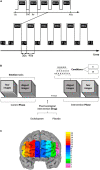Behavioral, cortical and autonomic effects of single-dose escitalopram on the induction and regulation of fear and disgust: Comparison with single-session psychological emotion regulation with reappraisal
- PMID: 36684004
- PMCID: PMC9845894
- DOI: 10.3389/fpsyt.2022.988893
Behavioral, cortical and autonomic effects of single-dose escitalopram on the induction and regulation of fear and disgust: Comparison with single-session psychological emotion regulation with reappraisal
Abstract
Introduction: Adaptive and successful emotion regulation, the ability to flexibly exert voluntary control over emotional experience and the ensuing behavior, is vital for optimal daily functioning and good mental health. In clinical settings, pharmacological and psychological interventions are widely employed to modify pathological emotion processing and ameliorate its deleterious consequences.
Methods: In this study, we investigated the acute effects of single-dose escitalopram on the induction and regulation of fear and disgust in healthy subjects. Furthermore, we compared these pharmacological effects with psychological emotion regulation that utilized a cognitive strategy with reappraisal. Emotion induction and regulation tasks were performed before and 4 h after ingestion of placebo or 10 mg escitalopram in a randomized, double-blind design. The International Affective Picture System (IAPS) was used as a source of images, with threat-related pictures selected for fear and disease and contamination-related pictures for disgust. Behavioral data, electrodermal activity (EDA), and functional near-infrared spectroscopy (fNIRS) recordings were collected.
Results: Escitalopram significantly reduced emotion intensity for both fear and disgust during emotion induction, albeit with differing electrodermal and hemodynamic activity patterns for the two negative emotions. At rest, i.e., in the absence of emotive stimuli, escitalopram increased sympathetic activity during the fear but not during the disgust experiments. For both fear and disgust, emotion regulation with reappraisal was more effective in reducing emotion intensity compared to pharmacological intervention with escitalopram or placebo.
Discussion: We concluded that emotion regulation with reappraisal and acute administration of escitalopram, but not placebo, reduce emotion intensity for both fear and disgust, with cognitive regulation being significantly more efficient compared to pharmacological regulation under the conditions of this study. Results from the fNIRS and EDA recordings support the concept of differential mechanisms of emotion regulation that could be emotion-specific.
Keywords: EDA; SSRI; disgust; emotion induction; emotion regulation; escitalopram; fNIRS; fear.
Copyright © 2023 Sklivanioti Greenfield, Wang and Msghina.
Conflict of interest statement
The authors declare that the research was conducted in the absence of any commercial or financial relationships that could be construed as a potential conflict of interest.
Figures




Similar articles
-
Similarities and differences in the induction and regulation of the negative emotions fear and disgust: A functional near infrared spectroscopy study.Scand J Psychol. 2022 Dec;63(6):581-593. doi: 10.1111/sjop.12836. Epub 2022 May 30. Scand J Psychol. 2022. PMID: 35634652 Free PMC article.
-
Emotion regulation of fear and disgust: differential effects of reappraisal and suppression.Cogn Emot. 2017 Feb;31(2):403-410. doi: 10.1080/02699931.2015.1110117. Epub 2015 Nov 12. Cogn Emot. 2017. PMID: 26563997
-
Differential effects of escitalopram challenge on disgust processing in obsessive-compulsive disorder.Behav Brain Res. 2012 Jan 1;226(1):274-80. doi: 10.1016/j.bbr.2011.09.029. Epub 2011 Sep 22. Behav Brain Res. 2012. PMID: 21963422
-
Fear or disgust? The role of emotions in spider phobia and blood-injection-injury phobia.Turk Psikiyatri Derg. 2011 Summer;22(2):115-22. Turk Psikiyatri Derg. 2011. PMID: 21638233 Review.
-
Emotion regulation from an action-control perspective.Neurosci Biobehav Rev. 2023 Oct;153:105397. doi: 10.1016/j.neubiorev.2023.105397. Epub 2023 Sep 20. Neurosci Biobehav Rev. 2023. PMID: 37739325 Review.
Cited by
-
Seeing Is Feeling: How Aphantasia Alters Emotional Engagement With Stories.Psychophysiology. 2025 Jul;62(7):e70100. doi: 10.1111/psyp.70100. Psychophysiology. 2025. PMID: 40641144 Free PMC article.
-
Behavioral intervention with task repetition compared to pharmacological intervention with SSRI for enhancement of cognitive control in emotional and non-emotional settings.Psychopharmacology (Berl). 2025 Jun 19. doi: 10.1007/s00213-025-06835-6. Online ahead of print. Psychopharmacology (Berl). 2025. PMID: 40536716
-
Emotional dysregulation and stimulant medication in adult ADHD.J Psychiatry Neurosci. 2024 Aug 9;49(4):E242-E251. doi: 10.1503/jpn.240009. Print 2024 Jul-Aug. J Psychiatry Neurosci. 2024. PMID: 39122408 Free PMC article.
References
-
- American Psychiatric Association. Diagnostic and Statistical Manual of Mental Disorders. 5th ed. Washington, DC: American Psychiatric Association; (2013). 10.1176/appi.books.9780890425596 - DOI
LinkOut - more resources
Full Text Sources

